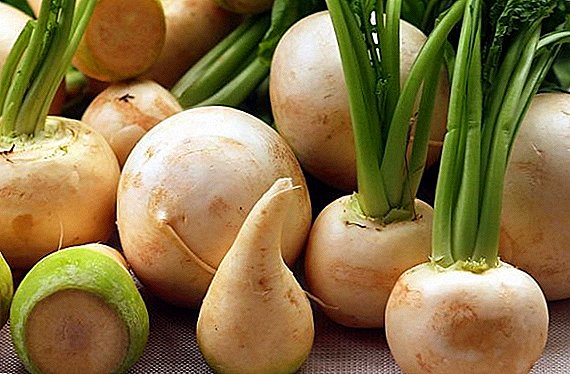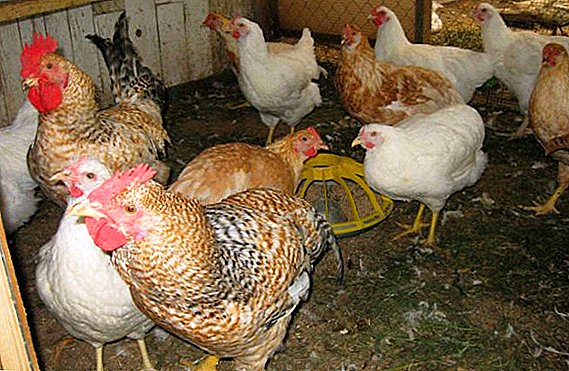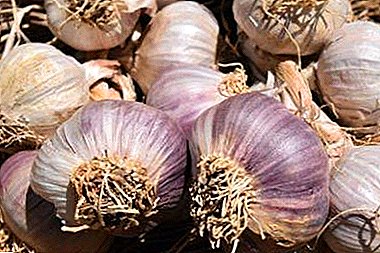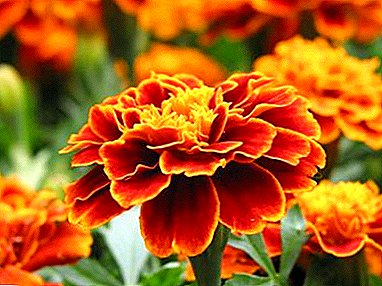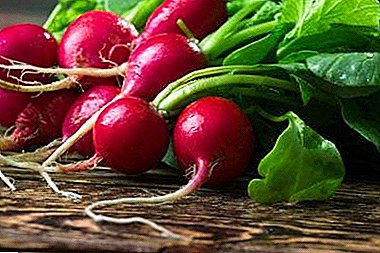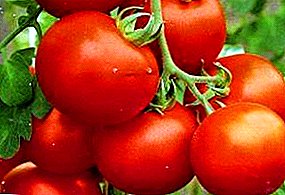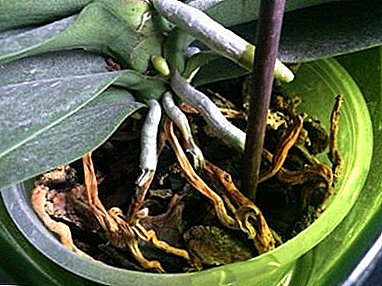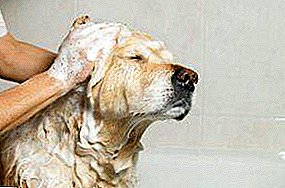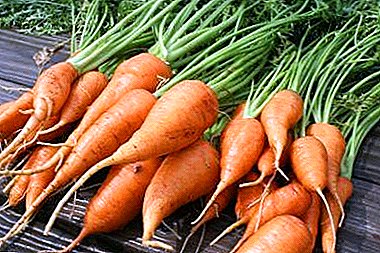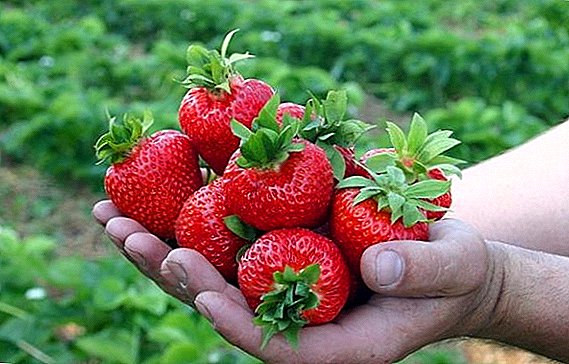 Anyone who has his own plot of land often considers it a right decision to grow strawberries on it. Juicy red berries are equally loved by both children and adults, and the “Russian size” is considered to be the most beloved strawberry variety in domestic plant growers, being a large-fruitful hybrid of strawberry. This variety attracts summer residents with an incredibly long period of fruiting, which stops only in October, with a decrease in air temperature at night.
Anyone who has his own plot of land often considers it a right decision to grow strawberries on it. Juicy red berries are equally loved by both children and adults, and the “Russian size” is considered to be the most beloved strawberry variety in domestic plant growers, being a large-fruitful hybrid of strawberry. This variety attracts summer residents with an incredibly long period of fruiting, which stops only in October, with a decrease in air temperature at night.
Important! Nutritionists advise eating strawberries separately from the main meal. The fact is that this tasty berry causes fermentation in the stomach, which negatively affects the work of the digestive system and may even cause intestinal colic and bloating.
Description strawberry variety "Russian size"
If you are going to grow strawberries of the "Russian size" variety on your garden plot, then you, of course, should read its detailed description. First of all, it is worth knowing that the yield of strawberries "Russian size" causes real admiration even among experienced gardeners: during the period of ripening on the bushes adorn juicy, large, reaching from 5 to 8 centimeters in diameter berries. By the way, the weight of one strawberry berry "Russian size", subject to all agrotechnical requirements, can reach as much as 50 g. 
Did you know? Strawberry is a powerful antidepressant. This berry contains an impressive amount of vitamins of group B, which makes its use especially important for those who suffer from increased emotional lability and nervousness. Drinking only 150 grams of such berries a day will help keep negative emotions under control.In addition to everything else, the berries of this variety have dense juicy and incredibly sweet flesh, and their flavor is remembered by even the real gourmet. Surprisingly, this variety, unlike all the others, almost never causes allergic reactions, which allows its use even for young children and allergies.
Garden strawberries "Russian size" conquered the hearts of gardeners with high productivity, because if you provide the bushes with comfortable conditions for growth and development, then with one plant you can collect more than 0.5 kilograms of juicy fragrant berries.
How to choose strawberry seedlings when buying
When buying strawberry seedlings "Russian size", it is very important to choose healthy plants. Brown, red, black dots and spots on the leaves of bushes indicate that they are infected with a fungal infection, so it is better to refrain from such an acquisition. If the vending bushes have suspiciously pale leaves, then this may be a sign of late blight necrosis of the horns. This phytoinfection refers to quarantine and if you buy infected planting material, then the seedlings are likely to die. If on the bushes you find shriveled young leaves, then this is a sure symptom of infection with an earthen mite. This pest will significantly reduce the adaptive capacity and yield of plants. 
Did you know? Strawberry - natural "Viagra". Contained in the seeds of berries zinc helps to increase sexual desire in both men and women. Moreover, it also increases the likelihood of conceiving a child by as much as 25%.High-quality seedlings of the Russian Size strawberry variety have:
- saturated dark green color of leaves;
- thickness of horns from 0.7 to 0.8 millimeters;
- fibrous root system (the length of the roots should not be less than 7-8 centimeters);
- healthy appearance;
- wet, not dried roots.
When to plant seedlings of garden strawberries on the plot
 In order for the Russian Size strawberry to be pleased with its generous yield and its cultivation was carried out without incident, it should be remembered that the best quality sockets and mustaches appear on the bushes in early spring or in early summer, because during this period the temperature is not too high and the moisture is more than enough. Based on the needs of strawberry bushes, we can conclude that the most appropriate time for their transplantation into the ground is the period starting around April 15 and May 5 or from July 25 to September 5. In the southern regions, planting of bushes in the spring period is carried out in early March, and ends - in late October. Of course, August is considered to be a better time for planting bushes in the ground.
In order for the Russian Size strawberry to be pleased with its generous yield and its cultivation was carried out without incident, it should be remembered that the best quality sockets and mustaches appear on the bushes in early spring or in early summer, because during this period the temperature is not too high and the moisture is more than enough. Based on the needs of strawberry bushes, we can conclude that the most appropriate time for their transplantation into the ground is the period starting around April 15 and May 5 or from July 25 to September 5. In the southern regions, planting of bushes in the spring period is carried out in early March, and ends - in late October. Of course, August is considered to be a better time for planting bushes in the ground.
This is the most favorable period for many reasons:
- at this time a lot of planting material;
- good weather for the fastest possible rooting of sprouts;
- plants have enough time to get stronger.
Choosing a place for planting strawberries
Strawberry bushes are very fond of light, which means that for their planting one should choose well-lit places where onions, legumes, root crops or garlic used to grow.
Important! An important factor affecting the size of strawberry fruiting is soil acidity. If acidic soil prevails on your site, then to create optimal conditions for growing strawberries, it is recommended to deoxidize it. For this purpose, ash or lime mortar is used.
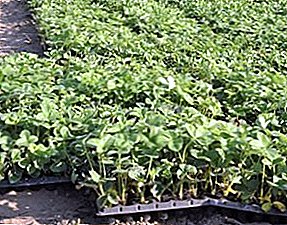 Ideally, the bed for planting strawberries was chosen in advance: in the spring it is planted with green manure, which is mowed in August, and then treated with a solution of EM preparations. An ideal green manure for strawberries is lupine. It is equally important before planting strawberry bushes on the site to clean it from weeds and properly prepare the ground. Note: strawberries are terribly gluttonous, so when preparing the beds you will need compost, ash, biohumus and manure. For seedlings prepare quite deep and wide holes. The distance between the holes should not be less than 30 or more than 50 centimeters, and between rows should be equal to 40 centimeters.
Ideally, the bed for planting strawberries was chosen in advance: in the spring it is planted with green manure, which is mowed in August, and then treated with a solution of EM preparations. An ideal green manure for strawberries is lupine. It is equally important before planting strawberry bushes on the site to clean it from weeds and properly prepare the ground. Note: strawberries are terribly gluttonous, so when preparing the beds you will need compost, ash, biohumus and manure. For seedlings prepare quite deep and wide holes. The distance between the holes should not be less than 30 or more than 50 centimeters, and between rows should be equal to 40 centimeters.Before planting seedlings, a nutrient mixture is added to each well, for the preparation of which one compost bucket, one manure bucket, a bucket of earth and two glasses of ash are mixed. In the center of each hole, a small mound is made from the prepared substrate, on which seedlings are placed.
Planting strawberry seedlings "Russian size" on the site
Strawberry variety "Russian size" unpretentious, but to plant young bushes was more successful, you should perform the manipulation on a cloudy day or in the evening. In addition, in order for the bushes to settle down faster, before transplanting them, it is necessary to water them well, or soak the seedlings before planting in the ground for a couple of hours in water with the addition of a biostimulator. Also, some plant growers before planting strawberry bushes in the ground are advised to soak them in a garlic infusion prepared at the rate of 150 milliliters of garlic infusion per 10 liters of water - an unpleasant garlic smell will scare away pests.
Did you know? Eating strawberries often saves you from headaches and can even lower body temperature. The thing is that the berries contain substances similar in their chemical composition to aspirin.Before planting plants in the ground, carefully inspect the bushes: it is desirable that each of them has 3 or a maximum of 4 healthy leaves, and all the rest should be removed immediately. If the roots of plants in length reach more than 10 centimeters, they must be cut. Now we set each bush on a hill in the center of the hole in such a way that the heart (the growth point of the bush) is flush with the surface of the bed, and the roots of the plant are neatly laid out on the hillsides.
 Holding the shrub upright, sprinkle it with the prepared substrate and at the same time pour water on it. This will improve the contact of the roots with the ground and speed up the formation of cornea. When planting bushes, it is necessary to ensure that the growth point is not deeply buried, but at the same time it does not rise too much above the level of the bed.
Holding the shrub upright, sprinkle it with the prepared substrate and at the same time pour water on it. This will improve the contact of the roots with the ground and speed up the formation of cornea. When planting bushes, it is necessary to ensure that the growth point is not deeply buried, but at the same time it does not rise too much above the level of the bed.Features of growing strawberry varieties "Russian size"
Care for strawberries "Russian size" does not take much of your time and effort. For maximum comfort of the bushes planted in the spring, you will have to systematically remove flower stalks and whiskers. The elimination of these elements will allow the plant to direct all forces to rooting, and not to the formation of fruits and reproduction.
In addition, you will have to ensure that plants receive enough moisture and feed, systematically fight weeds and periodically loosen the soil, as well as protect the bushes from diseases and pests.
Spraying against diseases and pests
In order to protect strawberry bushes from ticks and diseases (brown and white spots, and also powdery mildew) with the onset of the first warm spring days, all affected and dry overwintered leaves should be removed from the plants.
 The first spraying is carried out in the presence of traces of pathogens and lesions of bushes with gray rot, powdery mildew and spotting in early spring, before new leaves grow, using a 3% solution of Bordeaux mixture. If the bushes showed signs of infection with brown or white spot, then at the stage of vegetative growth they are sprayed with Euparen. During the period of intensive formation of buds, the plants are treated against pyrexia, Galitsa, as well as other insect pests by means of Actellic at the rate of 15-20 ml of the preparation per 10 liters of water. In the autumn, after harvesting, it is recommended to work strawberries with Topaz, Switchem or Euparine, to reduce the accumulation of infections, and in the presence of pest infestation with pests, the drug Actellic.
The first spraying is carried out in the presence of traces of pathogens and lesions of bushes with gray rot, powdery mildew and spotting in early spring, before new leaves grow, using a 3% solution of Bordeaux mixture. If the bushes showed signs of infection with brown or white spot, then at the stage of vegetative growth they are sprayed with Euparen. During the period of intensive formation of buds, the plants are treated against pyrexia, Galitsa, as well as other insect pests by means of Actellic at the rate of 15-20 ml of the preparation per 10 liters of water. In the autumn, after harvesting, it is recommended to work strawberries with Topaz, Switchem or Euparine, to reduce the accumulation of infections, and in the presence of pest infestation with pests, the drug Actellic.
Frequency and abundance of irrigation
The frequency of watering strawberries depends on weather conditions and is determined by the dryness of the soil. The best time to perform this procedure is earlier in the morning. Until the flowers appear, the bushes can be watered. Such watering resembles rain and well washes away the dust accumulated during the day from the leaves. If it is very hot outside, the plants should be watered once a week, and 10 to 25 liters of water should be poured into one square meter. After the appearance of the fruit on the bushes reduce watering. For irrigation strawberries use only warm water, the temperature of which is not lower than 20 ° C. Watering strawberries with cold water can cause plant contamination with powdery mildew or gray mold, which will cause the death of the entire crop.
Weed removal and soil loosening
 Weed control begins to lead to the planting of seedlings in the ground. But in order to prevent the overgrowing of the bed by weeds, which take away moisture and useful substances from your pets, it is necessary to carry out weeding throughout the entire period of ripening of berries and after harvesting. Loosening the beds is carried out once every eight days. The depth of loosening should be 10 cm, and when weeds are removed, it is recommended not only to harvest, but to take it out of the ground along with the root system, collect it in a bucket and carry it away from the garden.
Weed control begins to lead to the planting of seedlings in the ground. But in order to prevent the overgrowing of the bed by weeds, which take away moisture and useful substances from your pets, it is necessary to carry out weeding throughout the entire period of ripening of berries and after harvesting. Loosening the beds is carried out once every eight days. The depth of loosening should be 10 cm, and when weeds are removed, it is recommended not only to harvest, but to take it out of the ground along with the root system, collect it in a bucket and carry it away from the garden.
Top dressing strawberry bushes
The first time after planting strawberries, the introduction of the feed is carried out in the fall. This is a vital manipulation for depleted fruiting bushes. Fertilization helps the bushes recover and gives strength to endure wintering. After completion of fruiting, flower buds form on the plants, and therefore the future harvest depends entirely on the amount of nutrients obtained at this stage. In addition, strawberry bushes are fed in the offseason after transplantation, planting and reproduction by dividing the bushes.
Fresh manure or chicken manure is laid out between them during the autumn period for fertilizing the bushes with organic fertilizer, because during the winter it will have time to perepret, and in the spring it will simultaneously serve as a source of nitrogen, as well as mulch, warning the active development of weeds.
Humus can be brought into the ground and during the transplantation of bushes: they prepare a bump of it, which is then poured into the holes with the rosettes planted in them. Chicken dung, fresh, is not recommended, as it can cause root burns due to the high nutrient concentration. For feeding plants it must be diluted with water. The solution is introduced into the grooves dug between the holes and the rows of strawberries.
 In the spring, fertilization is carried out after the first loosening. During this period, good results are produced by the introduction of highly diluted chicken manure. To prepare the solution, one part of chicken excrement is taken and diluted in 20 parts of water. However, it is not recommended to use such dressing more often than once a year, since its excessive introduction will contribute to the accumulation of nitrates in the soil, which will then fall into the plants and you will not get an environmentally friendly crop.
In the spring, fertilization is carried out after the first loosening. During this period, good results are produced by the introduction of highly diluted chicken manure. To prepare the solution, one part of chicken excrement is taken and diluted in 20 parts of water. However, it is not recommended to use such dressing more often than once a year, since its excessive introduction will contribute to the accumulation of nitrates in the soil, which will then fall into the plants and you will not get an environmentally friendly crop.
The second feeding is carried out after the appearance of berries. For these purposes, use Diluted mullein, as he is considered the most suitable fertilizer for strawberries. Korovyak contains in the right quantity all the nutrients necessary for the normal development of strawberries. To prepare such food you need to take a quarter of a mullein bucket and fill it with water, mix and soak in a warm place for 3 days. The resulting concentrate, before the introduction, it is recommended to dilute in a ratio of 1: 4 and only then use it to pour the bushes.
In addition to organic, for fertilizing strawberry bushes in the spring, use and mineral fertilizers. Ammofosc and ammonium nitrate are excellent for this role at the rate of 2: 1. The resulting mixture is diluted in water and injected into the soil.
The most essential trace element for strawberries, during the formation of berries, is potassium, so the introduction of this element must be carried out during the flowering of the bushes. For feeding plants, you can use potassium monophosphate at the rate of 1 tablespoon per 10 liters of water, but the introduction of fertilizers into the soil should be carried out only after abundant watering of the bushes. Moisture protects plant roots from chemical burns.
Growing seedlings strawberries "Russian size" of seeds
Many growers are afraid to order seeds, because they do not know how to plant strawberries properly. And in vain! Properly grown seedlings from seed differs generous fruiting, and, in addition, it fully retains its varietal characteristics. The main difficulty in growing strawberry seedlings from seeds is that its grains have a very dense seed coat, which is virtually impossible to break through without additional stratification. 
At home, the seeds are placed in a humid environment and stratified in a refrigerator with slight positive temperatures.
To collect your own strawberry seeds you need:
- pick the largest, most beautiful and ripe berries from healthy bushes;
- cut off the tip of the fruit (the strongest plants grow from seeds obtained from the middle third of the berry);
- cut off the top layer of pulp together with the seeds and dry them on paper;
- the dried mass should be carefully grind to release the seeds;
- Ready received material to pour in a paper bag or jar and send to storage.
At the end of the stratification of seeds, in March they are sown in a pre-prepared substrate consisting of equal parts of peat and turf land, as well as a small amount of sand.
In each container lay one seed, sprayed with water from a spray bottle, covered with foil and put in a warm place. After a week, you will have the first timid shoots. At this stage, the plants will need to provide a sufficient amount of UV light. After the emergence of leaflets in the shoots (up to 5 cm in diameter), they are rolled into a large container. As soon as the seedlings reach the desired size, it is hardened and planted in the ground.
Strawberries are an unpretentious plant, but you still have to make some efforts to get a generous harvest of juicy and sweet berries.


